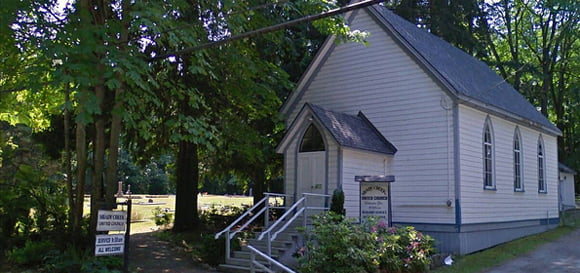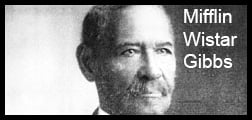BC Black History Timeline
According to the U.S. National Archives on Black Soldiers in the U.S. Military, roughly 179,000 Black men (10% of the Union Army) served as soldiers in the U.S. Army and another 19,000 served in the Navy. Nearly 40,000 Black soldiers died over the course of the war—30,000 of infection or disease.
Black soldiers served in artillery and infantry and also performed noncombat support functions. Black carpenters, chaplains, cooks, guards, labourers, nurses, scouts, spies, steamboat pilots, surgeons, and teamsters also contributed to the war cause. There were nearly 80 Black commissioned officers.
Black women who could not formally join the Army served as nurses, spies, and scouts, the most famous being Harriet Tubman. One of her most successful exploits was as a scout for the 2nd South Carolina Volunteers.
Source: Black Soldiers in the U.S. Military During the Civil War
On April 15, 1865, one week after the war ended, President Abraham Lincoln was assassinated by John Wilkes Booth in Washington, D.C.
The Emancipation Proclamation on January 1, 1863 did not mean immediate freedom form enslavement. Texas was the last and one of the largest bastions of institutional slavery, primarily because of the minimal build-up of Union troops. Plantation owners from areas relocated to Texas, forcibly taking the people they enslaved with them. Freedom finally came two years later on June 19, 1865, when General Gordon Granger led Union troops into Galveston Bay and declared the more than 250,000 enslaved Black people in Texas free by presidential decree. Celebrations broke out. Juneteenth was born and is the day emancipation is celebrated annually in many American communities.
Candidates running for election to the Victoria municipal council in 1865 were required to be property owners. While Abner Francis was on the “Real Estate Assessment Roll July 1, 1864 to June 30,1865” as owner of two properties, the 1862-1863 Property Assessment Roll was used to determine eligibility, and Francis did not own property in that year. Because of this discrepancy, Francis resigned the day after he was sworn in.
On November 17th, an editorial in the Colonist questioned why the most recent assessment roll was not used. “The assessment of 1862-3 is no more than a piece of waste paper …. The whole affair from beginning to end is a ‘mass’ of the most outrageous absurdity… ”
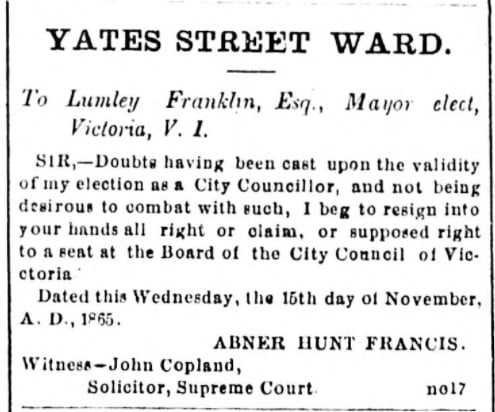
In 1865 the Davis Company was formed through a merger of the all-Black Harvey-Dixon Company and the all-white Davis Company. The new company found gold on a claim that had been abandoned by the all-white Aurora Company.
After the gold discovery, the Aurora Company asserted that it still had rights on that claim. On June 18, 1866, a jury decided that the claim would be divided equally between the Aurora and Davis Companies. However, the next day Chief Justice Matthew Baillie Begbie stepped in and, disregarding the colony’s mining regulations, re-interpreted the case to award the bulk of the claim to the Aurora Company.
He further ruled that the Black owners of the Davis Company were not entitled to any share of the Davis Company award. In recent years, Judge Begbie’s racism towards Black, Chinese and Indigenous people has been well documented.
An Act for the Union of the colonies was passed by the Imperial Parliament in August 1866 to become effective at noon on November 19, 1866. On that date, the union was proclaimed simultaneously in the two capitals, New Westminster and Victoria.
Mifflin Wistar Gibbs, one of the best known of the Black pioneers, was the first Black person to be elected in British Columbia and serve as a municipal councillor. He served as a councillor in Victoria from 1866 to 1869, representing the James Bay Ward. While on council, Gibbs chaired the Ways and Means Committee and from time-to-time acted as Deputy Mayor.
Read more about his unprecedented achievements.
On July, 1, 1867 The British North America Act came into effect marking the birth of the Dominion of Canada; comprising four provinces: Nova Scotia, New Brunswick, Quebec and Ontario. Ottawa was chosen as the capital and recently knighted Sir John A. Macdonald was the first prime minister.
In 1982, the Act was renamed the Constitution Act, 1867. The Act has been seen as destructive of Indigenous rights, because it gave the federal government jurisdiction over “Indians and Lands reserved for Indians.”
On September 14,1868, 26 delegates from the BC colonies met at Yale, BC for a convention of the Confederation League. The Confederation League was led by Amor de Cosmos, then a B.C. legislative council member. Mifflin Gibbs, represented Salt Spring Island.
The convention stimulated popular support for the union with Canada as a solution to the Colony of British Columbia’s financial problems. In 1970 BC commissioned a plaque commemorating the convention.
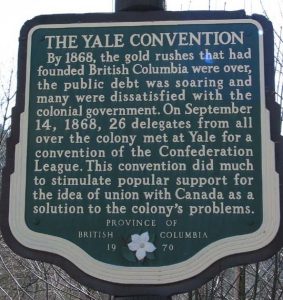
John Anderson, a local correspondent for “The Elevator” a San Francisco newspaper, wrote of the effects of the Barkerville fire, “Mr. Editor: —Since I last wrote you, we have met with a serious calamity— Barkerville has been entirely destroyed by fire, and it has been a ruinous loss to many…among the sufferers are our friends W.D. Moses, I.P. Gibbs, and Miss Hickman. Mrs. R. Gibbs saved her things, but lost her house”.
The Black residents mentioned are William Delany Moses who owned and operated a barbershop, I.P. Gibbs is a brother of Mifflin Gibbs. R. Gibbs is Rebecca Gibbs, a sister-in-law of Mifflin Gibbs, and one of Canada’s first Black female poets. Her poem about this fire was published in the Cariboo Sentinel and later in The Elevator. Her story
Some Black pioneers did return to the U.S. to fight in the Civil War and after the Civil War.
The abolition of slavery in the U.S. in 1865 made returning to their former homes seem more possible. Mifflin Gibbs returned to the U.S. late in 1869 (after the Yale Convention). In his biography he writes, “I had left politically ignoble; I was returning panoplied with the nobility of an American citizen.”
The legal framework had changed with the adoption of three new amendments to the U.S. Constitution. The 13th Amendment, ratified on December 6, 1865, abolished slavery. The 14th Amendment, ratified on July 21, 1868, granted citizenship to any person born or naturalized in the U.S. The 15th Amendment, ratified on March 30, 1870, declared that the right to vote shall not be denied on account of race, colour, or previous condition of servitude.
By 1871, the federal government of Canada finally promised to build a railway to British Columbia. However the railway was not completed until 1885! By a United Kingdom Order in Council, British Columbia became the sixth province on July 20,1871. Sir Joseph Trutch was appointed the first Lieutenant Governor, and the Legislative Assembly elected John Foster McCreight as the first Premier. Trutch was known for his anti-Indigenous policies. In 2022 both Victoria and Vancouver renamed Trutch St. in consultation with the area Indigenous nations.
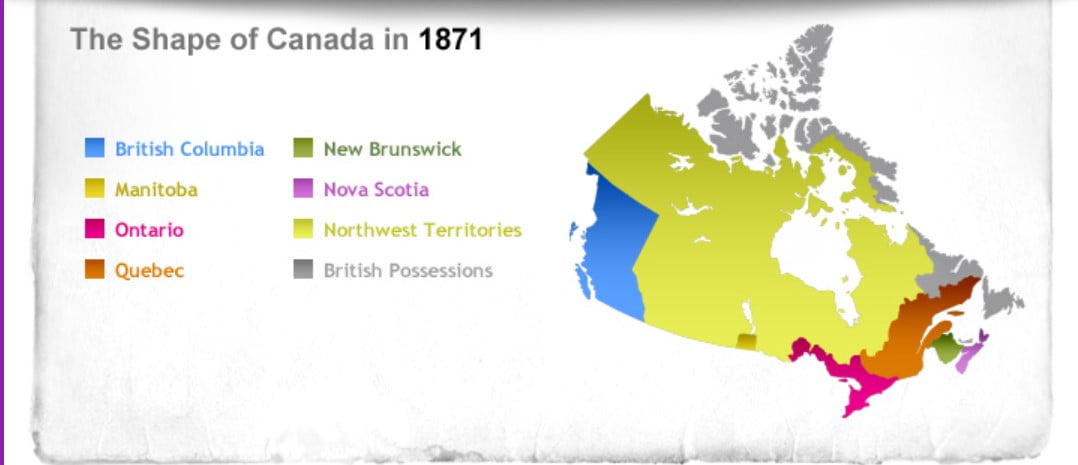
The total population of the province in 1871 was 36,427. That number included 8,576 (23.7%) British/Continental European, 1,548 (4.3%) Asian, and an estimated 25,661 (70.8%) Indigenous. Source: Jean Barman “The West Beyond the West”, pg. 429.
The official census for the Government of Canada reported 462 “coloured” people in the province. In Victoria, an informal census by the Victoria Police Department counted 128 “coloured” men and 89 “coloured”

John Sullivan Deas took over the salmon canning business that had been started by Edward Stamp and pre-empted the land between Delta and Richmond that now bears his name. The British Colonist newspaper reported on July 25, 1872, “At the Fishery which is carried on by Mr. Deas some 300 cases of canned salmon were already put up, four boats were constantly at work, the number of men employed is about 25.”

Although Peter Lester sat as a juror in February 1860, Black men were not on the “official list of jurors maintained by the Sheriff’s office” as had been promised by Governor Douglas.
In March 1872, Black residents presented a petition to the Legislative Assembly requesting that their names be added to the official list. On March 21, 1872 the Daily British Colonist reported “The resolution was lost 5 to 13”. The article reported “Dr. Ash replied that a colored man had never been summoned on a jury in Victoria and the reason seemed to be that white men object to sitting beside colored men.”
A resolution adding Black residents as jurors was finally passed in November 1872.
Image A-01626 Courtesy of Royal BC Museum and Archives
When the township of Salt Spring was incorporated in Spring 1873, John Craven Jones, the island school teacher, and Henry William Robinson, originally from Bermuda, were elected to the seven-member council. Robinson served as the council secretary.
Salt Spring Island remained incorporated for about 10 years. Today the island is an unincorporated rural Electoral District within the Capital Regional District (CRD).
Pompey Jackson is thought to be the oldest person buried at Ross Bay Cemetery (Site No. G42 W18). On October 3,1873 the British Daily Colonist carried a brief notice of his death “Old Jackson, a colored man, aged 111 years, died near the Royal Oak yesterday (October 2, 1873). He was born in Virginia in 1762. His death in 1873, age 111 indicates that if he was one of the settlers who arrived in 1858 he would have been about 96 at that time. There is indication that Jackson had been farming almost to the end. A year before his death, the Colonist reported on the civil case of Pompey Jackson vs. C. King involving a dispute about the ownership of a cow.
Emily Arabella (Emma) Stark was the daughter of Louis and Sylvia Stark. She was appointed the first teacher in the new North Cedar School in August 1874, becoming the first Black teacher on Vancouver Island. Emma grew up on Salt Spring Island, arriving with her parents, grandparents and 1 brother when she was just 4 years old. She completed high school in Nanaimo. Here’s her story
In the initial stages of this church, Blacks and whites met in homes for prayer meetings. On May 3, 1876, 15 people, including Black pioneers Fielding and Julia Spotts, Thomas W. Pierre and Augustus Christopher, met to organize the First Baptist Church. This was the first Baptist cause to be inaugurated in British Columbia, and the first Canadian Baptist church west of Winnipeg. Today, the First Baptist Victoria church is located at the corner of North Park and Quadra Streets, Victoria.
First Baptist Church History
Fielding and Julia Spotts were part of the first Black community that settled in Saanich, just north of Victoria. They had eight children. Fielding was a trustee at the schools their eight children attended; Lake District School circa 1870 and then at the South Saanich School circa 1879 to 1884. Their story
Image courtesy of Royal BC Museum and Archives
Grafton Tyler Brown is considered the first professional Black artist in the Pacific west. The one-week art exhibition, the first art exhibit in Victoria by any artist, included 22 paintings: views of Victoria, surrounding area and the mainland.
This photograph was taken in his studio at the Occidental Hotel in Victoria. The painting on the easel is “Valley of the Similkameen (1883)” This is his story
Royal B.C. Museum holds the greatest number of and most significant of Brown’s Canadian works. In March 2018 the Museum and Friends of the BC Archives Society purchased “Giant’s Castle Mountain: A.L. Fortune’s Farm, Enderby B.C.”, dated October 6, 1882; and in Feb 2022 RBCM purchased “Entrance to the Harbour”, Victoria B.C., May 1883, depicting Victoria’s harbour — “it was the signature painting in Brown’s 1883 exhibition.”
William Alan Jones was the first person to be granted a licence to practice dentistry (June 26,1886) under the British Columbia Dental Act. William received a degree at Oberlin College in 1857. He was the oldest of three brothers who came with the Black pioneers in 1858. After the American Civil War, he returned to Oberlin College to complete his dental studies and then returned to the gold rush town of Barkerville, where he had the nickname of “Painless Jones.” “Painless Jones: The Barkerville Dentist”
Image is a pencil sketch by Gene Grooms, local artist (1994); BC Black History Awareness Society Collection
150 passengers arrived on board the train of an engine, tender, baggage car, express and mail car, two emigrant sleepers, one first-class, one Pullman, and one private car. Hogan’s Alley in Vancouver’s Strathcona neighbourhood became home to many Black porters employed by the railroad.
Charles Alexander, one of the Black pioneers, initiated and assisted in the building of the original Shady Creek church in Saanich in the 1860’s. He was one of its first lay preachers. The congregation built a new building, completed in 1895 at its current location. The name of the church has changed as the community has grown. It was originally called Saanich Methodist Church then was known as South Saanich United Church. In 1952, the name was again changed to Shady Creek United Church and is now called Central Saanich United Church.
